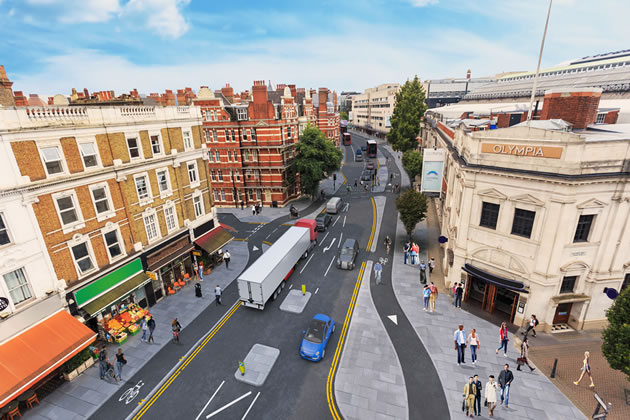Hammersmith Residents Split Over Cycle Superhighway
Newly released data shos 50% supported scheme while 47% were against

Artist's impression of superhighway looking west from Olympia
Hammersmith residents were evenly divided on the prospect ofCycle Superhighway 9 running from Olympia London along King Street to Chiswick and Brentford.
Data released with the consultation material for proposed revisions to the Cycle Superhighway 9 (CS9) plan has finally revealed the extent of local support for the scheme.
A total of 391 people within the W6 postcode responsed to the consultation, with 199 people supporting it - 170 strongly supporting and 26 simply supporting. That amounted to almost exactly 50% of the response.
On the other side, 184 were against it - with 132 strongly opposing and 52 simply opposing, amounting to 47%. The remaining 11 people were neither for or against.
The response further west was equally divided with Chiswick the only area where a clear majority of residents were in opposition.
Just 33% of Chiswick residents supported or strongly supported the plan with over 60% opposed or strongly opposed. The detailed postcode breakdown shows that there was majority opposition to the scheme in the postcode areas through which the cycle path would pass.
The overall majority in favour was based on overwhelming support for the project from other parts of London from which 81% of respondents backed the scheme.
Some of the strongest backingwas in the Isleworth area with 77% of people from that postcode area supporting the project.
The consultation on the original design in 2017 received 5,388 responses with 84% providing a postcode. Nearly 60 per cent of respondents supported the scheme. The new report shows that 56% of Hounslow Borough residents either opposed or strongly opposed the original design with 40% in favour.
In Hammersmith and Fulham borough there was a similar percentage in favour of the scheme as opposed it in Hounslow but just over half the number of responses. The highest number of responses came from residents of London boroughs not on the route with 81% of them supportive or strongly supportive of the plan.
Postcode Breakdown of Responses to CS9 Consultation
| Postcode district | Strongly Support | % | Support | % | Neither suppor nor oppose | % | Oppose | % | Strongly oppose | % | Total |
| W4 | 434 | 27 | 100 | 6 | 68 | 4 | 206 | 13 | 792 | 50 | 1600 |
| W6 | 170 | 43 | 26 | 7 | 11 | 3 | 52 | 13 | 132 | 34 | 391 |
| W14 | 111 | 44 | 15 | 6 | 2 | 1 | 31 | 12 | 93 | 37 | 252 |
| TW8 | 108 | 51 | 17 | 8 | 7 | 3 | 23 | 11 | 55 | 26 | 210 |
In the report on the original consultation the breakdown of levels of support by postcode was not given. Councillors in the Chiswick area and the local Assembly Member, Tony Arbour, claimed that the response that they had received from constituents to the scheme was overwhelmingly negative.
This site made a Freedom of Information request to be provided with the data in February of last year in an attempt to verify these claims but this was declined on the basis that the information needed further processing before being published in the future. An appeal was made against this decision but TfL continued to refuse to release the data. The matter was reported to the Information Commissioner’s Office and an investigation has been opened. It has been suggested that TfL did not want to put this information in the public domain because the Mayor, Sadiq Khan has said that his policy was not to support projects for which there was not local support.
The W4 postcode area was the only place where there was overall opposition to the scheme but it was also the area from which most responses were received. 56.4% of respondents from areas on the route of the superhighway were opposed to the scheme but this is largely a result of the level of opposition from the Chiswick area. Exactly half of the residents of W14 and W6 post code area supported the project with Brentford residents were in favour.
TfL did eventually publish this data in the report on the consultation released with the planned redesigns of the scheme including a rethink of how the path operates near to Kew Bridge and links up with Kew Bridge Road. However, the table of information was buried in an appendix at the end of the report. In the body of the report a number of map based visualisations of the responses were provided which didn’t make clear how support and opposition to the scheme was broken down.
Two public drop-in events will take place with staff available to answer questions:
- Wednesday 6 February 2019 (17:00 to 21:00), Clayton Hotel Chiswick, 626 Chiswick High Road, W4 5RY
- Saturday 16 February 2019 (11:00 to 15:00), Museum of Water and Steam, Green Dragon Lane, Brentford, TW8 0EN
The consultation on the revised designs for two sections of the route is now open and will run until 26 February. Full details can be found online Responses can be submitted online at tfl.gov.uk/kew-duke, by post to FREEPOST TFL CONSULTATIONS or by e-mail to consultations@tfl.gov.uk.